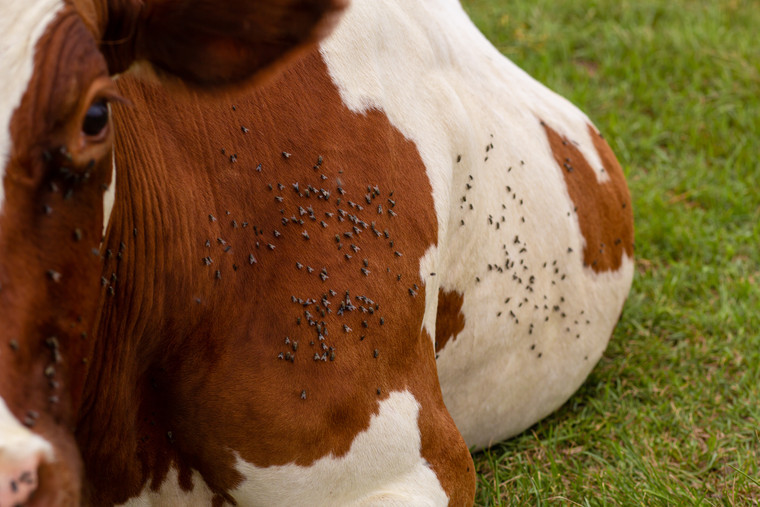Spring is here, giving us vets a rude awakening during our on-call nights. It is lovely to see some sun shining and some lambs out and about in the fields. Many cattle are still in, due to the ever-enjoyable rain, but thoughts will be rumbling about turn out. It is always a big relief to get stock out on grass and get the sheds cleared out, but one of the main concerns that goes with grazing is the dreaded fly.
There are many species of fly in the UK, such as stable, horn, house, face, and head flies. I only ever think of one word for flies and that is “nuisance”. Not only is their physical presence annoying but they are also important vectors of disease in our stock. They are irritating and can upset animals enough to reduce eating time and cause weight loss. They can transmit more exotic diseases such as Schmallenberg and bluetongue, but there are some more common issues that we see linked to the fly population.
Firstly, the much-dreaded fly strike; it is important to remember that fly strike is not limited to sheep. It can affect sick calves and cattle that become recumbent for any reason or those that have open skin wounds. Fly strike is important to bear in mind if you are late dehorning your calves, which creates a perfect environment for strike.
Clinical signs include a clearly irritated animal – pacing, scratching, tail twitching, nibbling at fleece, weight loss. Severe strike can cause discoloration of the fleece and the animal will be visibly ill, with depression, septicemia (systemic infection from toxins) and eventual death.
Act quickly with fly strike; clip the area and treat with something like Crovect, Spot on etc. Take care, as some products are only for prevention, not treatment e.g. Clik. The animal should have pain relief and, if severe, they will need antibiotics to prevent septicemia.
Pink eye/New Forest Eye/infectious keratoconjunctivitis is a bacterial infection of the eye. Flies will act as vectors and transport the bacteria from animal to animal. This can affect many animals in the group and an outbreak can sometimes seem endless. Signs will include runny eyes, tear staining on the cheek, eyelids closing or constantly twitching and discoloration of the eyeball itself (commonly white/blue). It can progress to ulceration and, in severe cases, some animals may need the eye removed to relieve pain. Catching this early is key and treatment is relatively simple at this point with some eye cream. Antibiotic injections may be needed if it has progressed. Please call us to discuss.
Summer mastitis, a bacterial infection of the udder, is also spread by flies. This is commonly seen in non-lactating heifers or cows. It can, however, sometimes affect bulls or calves. It is mostly seen in June to September, but it pays to always be vigilant.
Quite often, the early stages are missed but common signs include an enlarged teat or entire quarter. There is usually a pus discharge like clotted cheese. Wear gloves – it normally stinks! The animal may be noted as lame, but this is often an attempt to prevent rubbing the sore area. They can become stiff and can progress to real systemic illness with some getting gangrenous mastitis where some skin or the quarter itself may slough off.
These cows will need antibiotics, pain relief and possible supportive fluids etc, so please do not hesitate to call your vet to attend.
What can you do to help prevent and reduce fly-related disease?
- Teat sealants – these work well in dairy heifers and dry cows but are generally more impractical in beef cattle.
- Fly repellants – start using them early. Get a head start on the flies and keep the population reduced as much as possible. This can be from March onwards. Most are repeated every four to six weeks, but follow the manufacturer’s instructions. Most of these are pour on solutions containing things like permethrin, deltamethrin and cypermethrin.
- Fly tags – these are impregnated with fly repellant and can be applied to one or both ears.
- Manage the grazing areas– keep cattle away from places that are damp or have a lot of trees, which are ideal breeding grounds for flies. Keep any dung piles away from grazing spots.
- Sheep – spraying with Clik, Crovect, Ectofly etc, is critical to prevent flystrike, as well as reducing fleece around the back end and keeping on top of internal parasite management to prevent scours that attract flies.
- Clover Friendly Flies – a sustainable scheme which uses natural parasites of the flies (pteromalid wasps, also known as fly parasites). These wasps parasitise the flies listed here and reduce the numbers irritating the stock. Ask your vet for more information as they can usually supply the fly parasites.
- Be vigilant – check stock frequently to pick up and treat issues early.




